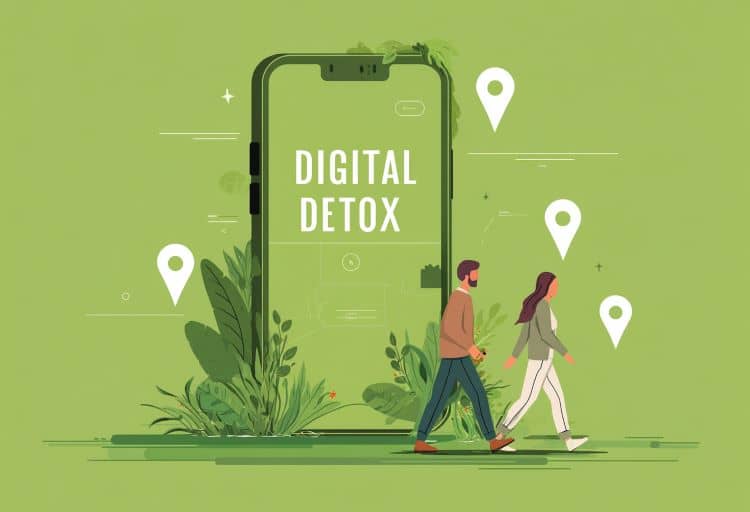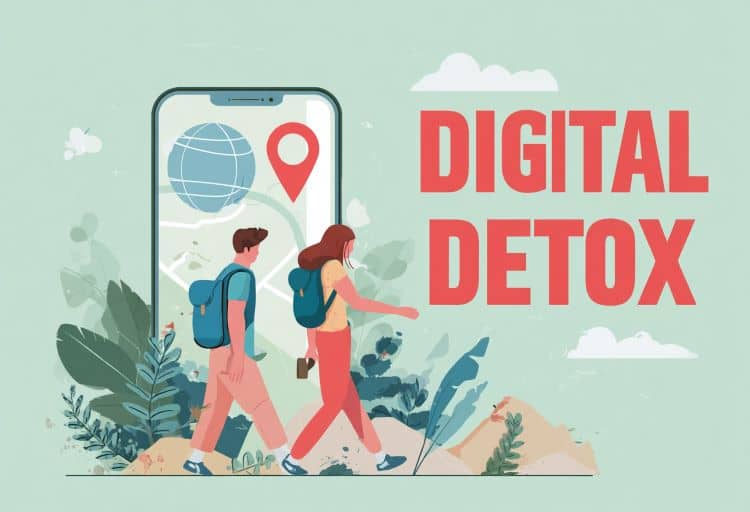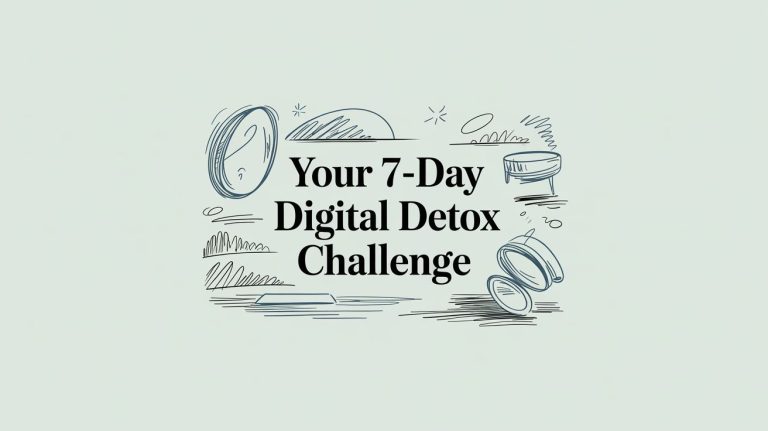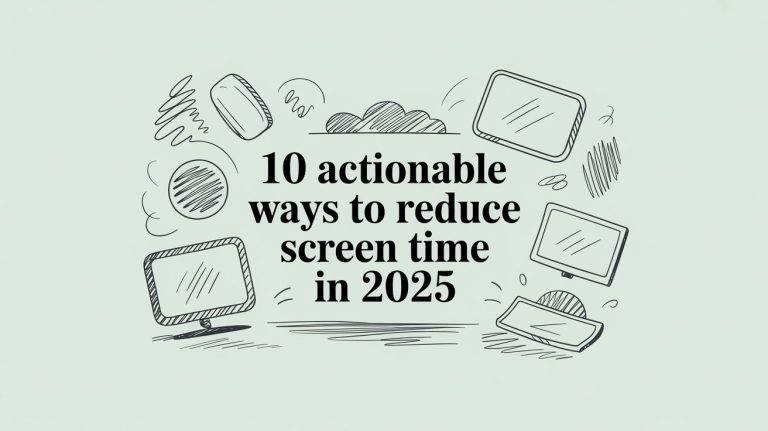How to Plan a Weekend Digital Detox: A Step-by-Step Checklist
Let’s be honest for a second. When was the last time you went an entire hour without a notification, a ping, a buzz, or the almost gravitational pull to just “check one thing”? For most of us, our digital devices have become phantom limbs. We feel their absence, we’re tethered to them from the moment our smartphone alarm jolts us awake to the last late night scroll through social media. If you’re feeling mentally cluttered, perpetually distracted, and a little less connected to the real world, you are not alone. The constant digital barrage can leave us feeling drained and anxious. This is where learning how to do a digital detox comes in, not as a punishment, but as a luxurious reset button for your brain.
Think of this article as your friendly guide, your step by step plan for reclaiming a weekend for yourself. We’re going to walk through everything, from understanding what a digital detox really means to a detailed checklist that will set you up for success. By the end, you’ll feel empowered to unplug, recharge, and rediscover the joy of an unfiltered life, even if it’s just for 48 hours.
Meaning of Digital Detox
Before we dive into the “how,” let’s clear up the “what.” The term “digital detox” sounds intense, maybe even a little scary. It might conjure images of living in a cave or giving up your phone forever. In reality, it’s much simpler and way more approachable.
A digital detox is a conscious, voluntary period where you step away from your digital devices. This includes smartphones, computers, tablets, and even smartwatches. It’s not about proclaiming technology as evil or becoming a Luddite. Instead, it’s about intentionally creating space in your life to disconnect from the constant stream of digital information and reconnect with yourself, your immediate surroundings, and the people right in front of you.
Think of it like a nutritional cleanse. You’re not swearing off food forever; you’re just giving your system a break from processed junk to reset itself. A digital detox does the same for your mind. It clears out the mental clutter, quiets the endless noise, and allows your brain to function in a more natural, focused state. It’s a temporary, intentional period of digital quiet that can have profound and lasting benefits on your overall well being. The goal isn’t to end your relationship with technology but to reshape it into something healthier, more mindful, and more intentional.
Top Digital Detox Benefits
So, you give up your phone for a weekend. What’s the big deal? Is the struggle really worth the reward? The answer is a resounding yes. The benefits of stepping away from the screen extend far beyond just having a bit of quiet time. They touch every aspect of your life, from your mental health to the quality of your sleep and your relationships.
Reclaim Your Peace and Quiet Your Mind
Our brains are not wired for the relentless influx of information we experience daily. Every notification, email, and social media update triggers a small but measurable stress response. The American Psychological Association has highlighted how this constant connectivity, or “technology and social media use,” can contribute to higher levels of chronic stress. Your body is perpetually in a low grade “fight or flight” mode.
When you unplug, you give your nervous system a much needed vacation. The constant pressure to respond, to “like,” to share, to keep up, simply vanishes. You’ll likely notice a decrease in anxiety and a sense of calm that you haven’t felt in a long time. It’s the feeling of finally being able to take a full, deep breath after holding it for too long. You allow your mind to be quiet, and in that quiet, you can find a profound sense of peace.
Supercharge Your Focus and Unleash Your Creativity
In his groundbreaking book “Deep Work,” Cal Newport argues that our ability to perform cognitively demanding tasks is a skill that is becoming increasingly rare and valuable. Constant digital interruptions shatter our focus, leading to shallow, fragmented thinking. We hop from app to app, task to task, never allowing our brain to sink deeply into one thing.
A digital detox is the ultimate deep work training camp. By removing the primary source of distraction, you force your brain to retrain its focus muscle. Suddenly, you can read a book for hours without interruption. You can have a conversation and truly listen. This newfound focus doesn’t just feel good; it unlocks higher levels of thinking and problem solving.
Furthermore, boredom, an experience many of us actively avoid with our phones, is a powerful catalyst for creativity. When your mind isn’t being spoon fed content, it starts to wander and make novel connections. A study published in the Academy of Management Discoveries found that boredom can actually spark individual productivity and creativity. That moment you’re staring out the window with nothing to do? That’s not wasted time; that’s your brain’s creative engine warming up.
Finally Get a Great Night’s Sleep
Are you guilty of the “one last scroll” in bed? You’re not doing your sleep any favors. The blue light emitted from our screens is a notorious saboteur of good sleep. According to Harvard Medical School researchers, blue light exposure in the evening suppresses the secretion of melatonin, the hormone that signals to your body that it’s time to sleep. This disrupts your circadian rhythm, making it harder to fall asleep, stay asleep, and get the deep, restorative rest your body craves.
During a digital detox, your evenings are naturally screen free. You might read a physical book, have a conversation, or listen to music instead. This allows your body’s melatonin production to function as nature intended. Many people report having some of the best, most refreshing sleep of their lives during a digital detox. You wake up feeling genuinely rested, not groggy and reaching for the caffeine.
Strengthen Your Real Life Connections
One of the most heart wrenching ironies of our hyper connected world is how it can make us feel more disconnected from the people we care about most. Have you ever been mid conversation with someone, only to see their eyes glaze over as they glance at a notification on their phone? This phenomenon, known as “phubbing” (phone snubbing), can be incredibly damaging to relationships. It sends a clear message: whatever is happening on this screen is more important than you.
A digital detox forces you to be fully present. When you’re at dinner with your partner, you’re at dinner with your partner. You’re listening, making eye contact, and sharing experiences without a screen acting as a third wheel. This level of presence is a powerful gift to your relationships. It fosters deeper intimacy, understanding, and a more genuine sense of connection. You might be surprised at the quality of conversations and the meaningful moments that emerge when technology is taken out of the equation.

How to Do a Digital Detox: Your Step by Step Weekend Plan
Alright, you’re convinced. You’re ready to trade swipes and scrolls for some soul restoring silence. But where do you even begin? A successful detox doesn’t just happen; it requires a little bit of planning. Follow this step by step checklist to design a weekend that leaves you feeling refreshed, not restless.
Step 1: Set Your ‘Why’ — Define Your Intentions
Before you do anything else, grab a pen and paper and ask yourself: Why am I doing this? Your answer is your North Star. It’s what will motivate you when the urge to check your email becomes overwhelming. A vague goal like “I want to be on my phone less” is not enough. Get specific.
Maybe your ‘why’ is:
- “I want to sleep through the entire night for two nights in a row.”
- “I want to have a full weekend of uninterrupted, quality time with my kids.”
- “I want to finish the novel that’s been sitting on my nightstand for six months.”
- “I want to reduce my anxiety and feel more present and calm.”
Writing these intentions down, as many digital detox retreat planners suggest, solidifies your commitment. This isn’t about deprivation; it’s about what you hope to gain. Frame it as a positive journey toward your goal.
Step 2: Prep the People — Announce Your Unplugging
Don’t just disappear. Going offline without a heads up can cause unnecessary worry for your loved ones and potential stress for you when you plug back in. A little communication goes a long way.
A few days before your detox, send a simple text or email to key people, friends, family, and maybe even your boss or close colleagues. Something like: “Heads up! I’m doing a digital detox this weekend to recharge. I’ll be offline from Friday evening until Monday morning. For anything truly urgent, you can call my partner’s phone or leave a voicemail, but I won’t be checking texts or emails. Talk to you Monday!”
Setting up an autoresponder on your email is also a great idea. This manages expectations and prevents you from returning to a mountain of messages from people wondering where you are. This straightforward digital detox checklist step is crucial for a stress free experience.
Step 3: Sanitize Your Space — Create a Tech-Free Haven
Out of sight, out of mind. This old saying is your best friend during a digital detox. Willpower is a finite resource, so don’t waste it fighting temptation all weekend. Make it easy on yourself by creating an environment that supports your goal.
Start by designating a “device drop zone.” This could be a drawer, a box, or a basket. When your detox begins, all devices go into the zone and stay there. This includes laptops, tablets, smartwatches, and of course, your phone.
Next, establish tech free zones in your home. The bedroom and the dining table are two non negotiable areas. This helps you protect your sleep and your mealtimes, turning them into sacred, screen free periods. If you’re doing this with your family, getting everyone on board is key. Making it a household rule, as recommended by guides on digital detoxing for families, turns it into a fun, collaborative challenge rather than a restriction. Turn off the TV and let silence or music fill the space instead.
Step 4: Pack Your ‘Analog’ Toolkit
A huge part of our device dependency comes from a reliance on their utility. Our phones are our alarm clocks, our GPS, our encyclopedias, and our cameras. The key to a successful detox is to have analog alternatives ready to go. Preparing this toolkit is not just practical; it’s a fun and mindful part of the process. Courtney Carver, the mastermind behind Be More with Less, champions the idea of having a detox toolkit to replace digital crutches.
Here’s a handy table to help you build your own toolkit:
| Digital Crutch | Analog Alternative | Why It’s a Game Changer |
|---|---|---|
| Smartphone Alarm Clock | A physical, standalone alarm clock | Prevents you from starting and ending your day with your phone in hand. It breaks the cycle of “just one look” before bed and upon waking. |
| Google Maps/Waze | A paper map, or directions written down beforehand | Encourages spatial awareness and observation. You’ll notice landmarks and street names you’d otherwise miss while following a blue dot. |
| Spotify or Podcasts | A record player, CD player, or even the radio | Turns listening to music into a more intentional act. It removes the risk of getting sucked into the rabbit hole of app notifications. |
| Kindle or E-reader | A physical paperback or hardcover book | Eliminates exposure to sleep disrupting blue light and the temptation to switch to another app. The tactile feel of paper is also incredibly grounding. |
| Social Media Apps | A journal and pen, sketchbook, or a board game | Promotes inward reflection or direct, face to face social interaction. You create your own content or connect with others instead of passively consuming. |
| Camera Phone | An old film camera or a simple digital camera (no Wi-Fi) | Forces you to be more deliberate with your shots. You focus on capturing the moment rather than immediately sharing it. |
Step 5: Plan Your Play — Schedule Screen-Free Fun
This is the most important step. A digital detox will feel like a punishment if you don’t fill the void with fulfilling activities. The goal is not boredom and deprivation; it’s engagement and enrichment. You suddenly have a wealth of time and attention at your disposal. Use it!
Don’t overschedule, but have a loose structure in mind. A great approach is to plan one or two anchor activities for each day. Here are some ideas:
- Get into Nature: Go for a long hike, visit a park, go to the beach, or do some gardening. Nature is a powerful antidote to digital overload.
- Get Creative: Pull out that old guitar, work with watercolors, try a new recipe that requires your full attention, or tackle a DIY project you’ve been putting off.
- Get Moving: Try a yoga class, go for a long bike ride, or just take a leisurely walk around your neighborhood without headphones. Notice the sounds and sights.
- Get Social (the Old-Fashioned Way): Plan a board game night with family, meet a friend for coffee (with a no phones rule), or write a long overdue letter to a relative. As one Washington D.C. based organization points out, offline activities are key.
- Get Quiet: Read. Meditate. Lie on an English countryside retreat (even if it’s just your own backyard) and watch the clouds. Let your mind be still.
Step 6: Embrace the Awkward — Navigating the Urges
Let’s be real: at some point, you’re going to feel it. The phantom vibration in your pocket. The sudden, intense urge to know what’s happening on Instagram. The feeling of boredom or anxiety that your brain has been trained to soothe with a quick scroll. This is normal. It’s the digital equivalent of withdrawal.
Don’t fight these feelings or judge yourself for having them. Instead, get curious. When the urge strikes, just notice it. What triggered it? Boredom? Loneliness? Habit? Take a deep breath. Instead of reaching for your phone, reach for your journal and write down what you’re feeling. This act of noticing is a powerful mindfulness practice. It helps you understand your own digital habits on a much deeper level. This discomfort is where the growth happens.
Step 7: The Afterglow — Reflect and Reintegrate
When your detox weekend is over, resist the urge to dive headfirst back into the digital chaos. The reentry is just as important as the detox itself. Before you turn your phone back on, take 15 minutes to reflect on your experience.
Journal about it. What did you enjoy the most? What was the hardest part? What did you notice about yourself and your habits? Did anything surprise you?
The goal of a weekend detox is not just to survive 48 hours without a screen but to bring some of that intentionality back into your daily life. Based on your reflections, decide on one or two small, sustainable changes you can make. Maybe it’s a “no phones in the bedroom” rule. Maybe it’s deleting the one app that causes you the most stress. This is how you move from a one time detox to a long term, healthier digital lifestyle.
Digital Detox App: An Oxymoron or a Helping Hand?
It seems like a strange paradox, doesn’t it? Using an app to help you stop using apps. The idea of a “digital detox app” can feel counterintuitive, but for some people, these tools can be a useful bridge to building better habits.
There are different kind of digital detox apps, some like Forest, Freedom, or Offtime, generally work by allowing you to temporarily block access to certain distracting websites and applications. The argument for using them is that they provide external scaffolding for your willpower, which can be weak, especially when you’re just starting out. An app can enforce the boundaries that you find difficult to maintain on your own. For example, the Forest app has a gamified approach where you grow a virtual tree during your focus time; if you leave the app, the tree withers. This small incentive can be surprisingly effective.
On the other hand, the ultimate goal of digital detoxification is to cultivate internal discipline. You want to reach a point where you don’t need a digital nanny to keep you offline. The risk of relying too heavily on these apps is that you’re still outsourcing your self control to a piece of technology.
The balanced view is to see them as potential training wheels. They can be incredibly helpful for your first few detoxes or for implementing specific, daily tech-free periods (like a 2 hour block of deep work). Use them as a tool to understand your patterns and build your focus muscle, with the eventual goal of being able to achieve that focus without their help.
Digital Detoxification: Making It a Lifestyle, Not a Fad
A weekend digital detox is a powerful reset, but its true magic lies in the lessons you carry forward. The real transformation happens when digital detoxification becomes less of a dramatic, once a year event and more of an integrated part of your life. It’s about building a sustainable, healthy relationship with technology for the long haul.
Start with Mini-Detoxes
You don’t have to go all in for a full weekend right away. Start small. Try a “Tech Free Evening” once a week. Institute a family rule of “no devices at the dinner table,” no exceptions. Or simply choose an hour every day, perhaps right when you get home from work, to put your phone away and be fully present. These mini detoxes build momentum and make the idea of unplugging feel less intimidating.
Curate Your Digital Diet
Not all screen time is created equal. Passively scrolling through an endless feed that makes you feel bad about yourself is very different from a video call with a loved one or learning a new skill on YouTube. Become a conscious curator of your digital world. Unfollow accounts that trigger anxiety or comparison. Unsubscribe from email lists you never read. Turn off all non essential notifications. Every buzz and ping that you eliminate is a small victory for your attention. This proactive digital housekeeping reduces the noise before it even reaches you.
Schedule Your Unplugging
Just as you schedule appointments and workouts, schedule your time to unplug. Maybe you decide that the first weekend of every quarter is a full digital detox weekend. Maybe you commit to a “Screen Free Sunday” every week. By putting it on your calendar, you give it the same importance as any other commitment. You’re proactively carving out time for your mental health, rather than waiting until you feel completely burned out.
In the end, learning how to do a digital detox is less about escaping the modern world and more about learning how to live more fully within it. It’s about recognizing that your attention is your most valuable and finite resource. You get to decide where you invest it. By intentionally stepping away from the screens, you are choosing to invest that precious attention in your well being, your relationships, and the quiet, beautiful, unfiltered world that is always waiting for you. It’s not about what you’re giving up, but all the incredible things you stand to gain. Find our digital detox apps on the homepage.




